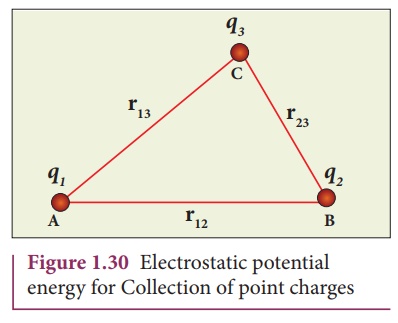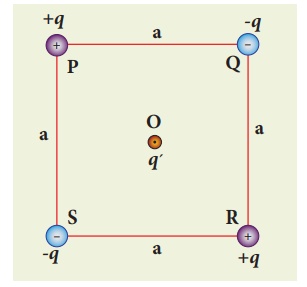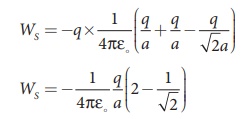Chapter: 12th Physics : Electrostatics
Electrostatic potential energy for collection of point charges
Electrostatic potential energy for collection of
point charges
The electric potential
at a point at a distance r from point charge q1 is
given by

This potential V
is the work done to bring a unit positive charge from infinity to the point.
Now if the charge q2 is brought from infinity to that point
at a distance r from q1, the work done is the product
of q2 and the electric potential at that point. Thus we have
W = q2V
This work done is stored
as the electrostatic potential energy U of a system of charges q1
and q2 separated by a distance r. Thus we have

The electrostatic
potential energy depends only on the distance between the two point charges. In
fact, the expression (1.45) is derived by assuming that q1 is
fixed and q2 is brought from infinity. The equation
(1.45) holds true when q2 is fixed and q1
is brought from infinity or both q1 and q2
are simultaneously brought from infinity to a distance r between them.
Three charges are
arranged in the following configuration as shown in Figure 1.30.

To calculate the total
electrostatic potential energy, we use the following procedure. We bring all
the charges one by one and arrange them according to the configuration as shown
in Figure 1.30.
(i) Bringing a charge q1
from infinity to the point A requires no work, because there are no other
charges already present in the vicinity of charge q1.
(ii) To bring the second
charge q2 to the point B, work must be done against the electric
field created by the charge q1. So the work done on the
charge q2 is W = q2 V 1B.
Here V1B is the electrostatic potential due
to the charge q1 at point B.

Note that the expression
is same when q2 is brought first and then q1
later.
(iii) Similarly to bring
the charge q3 to the point C, work has to be done against the total
electric field due to both charges q1 and q2.
So the work done to bring the charge q3 is = q3
(V1C + V2C). Here V1C is
the electrostatic potential due to charge q1 at point
C and V2C is the electrostatic potential due to charge q2
at point C.
The electrostatic
potential is

(iv) Adding equations
(1.46) and (1.47), the total electrostatic potential energy for the system of
three charges q1, q2 and q3 is

Note that this stored
potential energy U is equal to the total external work done to assemble the
three charges at the given locations. The expression (1.48) is same if the
charges are brought to their positions in any other order. Since the Coulomb
force is a conservative force, the electrostatic potential energy is
independent of the manner in which the configuration of charges is arrived at.
EXAMPLE 1.15
Four charges are arranged at the
corners of the square PQRS of side a as shown in the figure.(a) Find the work
required to assemble these charges in the given configuration. (b) Suppose a
charge q′ is brought to the center of the square, by keeping the four charges
fixed at the corners, how much extra work is required for this?

Solution
(a) The work done to arrange the
charges in the corners of the square is independent of the way they are
arranged. We can follow any order.
(i) First, the charge +q is brought
to the corner P. This requires no work since no charge is already present, WP
= 0
(ii) Work required to bring the
charge –q to the corner Q = (-q) x potential at a point Q due to +q located at
a point P.
WQ = −q × 1/4πε . q/ = −
1/4πε . q2/a

(iii) Work required to bring the charge +q to
the corner R= q × potential at the point R due to charges at the point P and Q.

(iv) Work required to bring the
fourth charge –q at the position S = q × potential at the point S due the all
the three charges at the point P, Q and R

(b) Work required to bring the
charge q′ to the center of the square = q′ × potential at the center point O
due to all the four charges in the four corners
The potential created by the two +q
charges are canceled by the potential created by the -q charges which are
located in the opposite corners. Therefore the net electric potential at the
center O due to all the charges in the corners is zero.
Hence no work is required to bring
any charge to the point O. Physically this implies that if any charge q′ when
brought close to O, then it moves to the point O without any external force.
Related Topics